Final report for ONC16-022
Project Information
Using cover crops to create an in situ mulch is one way that organic farmers can explore no-till techniques. While there has been some success with organic no-till row crops, organic no-till vegetables remain a conundrum. Inadequate weed control, narrow cover crop termination windows, and planting delays related to termination are all challenges. This project explored the use of season-long managed fallow concluding with high-residue, winter-killed cover crops to create a weed free mulch that does not need exact timing or special equipment for termination. The primary cover crop was sorghum sundangrass, which is known for producing large amounts of biomass. Farmer cooperators chose tomatoes as the vegetable crop because they generally benefit from mulch and have high value.
In 2016 we used two rounds of cover crops to reduce weeds in the trial areas on three cooperating farms in Dane County, Wisconsin. In July we established no-till treatment plots with (1) sorghum sudangrass alone, (2) sorghum sudangrass and sunn hemp, and (3) sorghum sudangrass and cow peas. The control was sorghum sudangrass to be managed with conventional tillage and plastic mulch. In the fall, just before frost, we rolled the cover crops with a disengaged rotovator to align the residue into an even mulch mat.
By May of 2017, it was clear the cover crop residue would not provide adequate weed control for the cropping year. The project then pivoted to look at three supplemental mulch materials used to exclude weeds in the no-till tomatoes: (1) plastic, (2) landscape fabric, (3) marsh hay. We tracked labor time, soil temperature, plant survivorship, and yield and analyzed all the data for differences.
Key Findings
Sorghum Sudangrass Residue for No-Till:
- Even with 10,000 or more pounds of dry sorghum sudangrass biomass in the fall, the remaining spring residue covered only 20% - 60% of the ground and was not adequate for use as a no-till mulch.
- Rolling the sorghum sudangrass with a disengaged tiller just prior to frost was quick, easy, and did a good job of aligning the residue.
- Sorghum sudangrass smothered not only weeds but also the sunn hemp and cow peas planted as leguminous companion cover crops.
- The sunn hemp attracted Japanese beetles, which makes it a less desirable cover crop on farms with vegetables that are susceptible to Japanese beetle damage.
Mulches for No-Till Tomatoes:
- Tomato yields were the same for all the no-till mulches and the conventionally tilled and plastic mulched control.
- Given that there was no yield penalty, it is worth experimenting with no-till tomatoes, especially when wet soils prevent or delay tillage.
- Soil temperature under the marsh hay was significantly lower than the other two treatments and the control.
- Tomato harvest from the marsh hay plots was equal to, but peaked later than, the other treatments, likely due to the lower soil temperature.
- Labor in each no-till system was different, with the marsh hay requiring the least time and the plastic requiring the most. The control required less time than any of the no-till systems.
- Weed control under all the no-till mulches was excellent, even through they were applied directly on top of sprouted weeds.
Objective 1: Assess three cover crop combinations of high-residue, winter-killed mulch for production of no-till organic tomatoes as compared to a conventionally tilled plastic mulch.
We collected population density and biomass for weeds and cover crops in the fall and again in the spring. We also did a visual assessment of the cover crop residue in the spring. When it became clear the residue would not be enough to exclude weeds in the cropping year, we adjusted the project and added objective 2 below.
Objective 2: Assess three supplemental mulches for use in no-till tomatoes as compared to a conventionally tilled, plastic mulched control.
To measure the effect of the mulches and associated management costs, we tracked labor time, soil temperature, plant survivorship, and tomato yield. An analysis of variance (ANOVA) was conducted using the R package lme4 (Bates et al 2015). Means and 90% confidence intervals for each treatment were calculated with the R package lsmeans (Lenth 2016). A confidence level of 90% was used, meaning that for each comparison that is statistically significant, we are 90% confident that the difference is due to the treatments and not to chance variation.
Objective 3: Share information with growers through a field day in 2017.
We held a field day at Crossroads Community Farm 8/31/17. The 32 attendees toured the trial plots, received a handout with the results to date, and discussed pros and cons of organic tomato no-till.
Objective 4: Create an illustrated info sheet and short video with project results and recommendations to be posted on the FairShare website and disseminated through the FairShare listserv.
Two bulletins and two videos were completed and distributed in May 2018. See information products.
Objective 5: Contribute information to the development of longer, multi-year reduced tillage vegetable rotations.
Results of the project were used to draft farmer recommendations for organic no-till tomatoes and distributed through the bulletins and videos.
References:
Bates, Douglas, Martin Maechler, Ben Bolker, Steve Walker (2015). Fitting Linear Mixed-Effects Models Using lme4. Journal of Statistical Software, 67(1), 1-48. doi:10.18637/jss.v067.i01.
Lenth, Russell V. (2016). Least-Squares Means: The R Package lsmeans. Journal of Statistical Software, 69(1), 1-33. doi:10.18637/jss.v069.i01
Cooperators
- (Researcher)
Research
Three diversified vegetable farms in Dane County, Wisconsin participated in this project. All the farms are certified organic. Each farm had three replicates of three no-till mulch treatments applied over the sorghum sudangrass residue: (1) green or black plastic, (2) black landscape fabric, and (3) marsh hay. The control was managed with conventional tillage and green or black plastic mulch. All plots were irrigated with drip tape under the mulch. The tomato variety was Monica, which is a determinate paste tomato.
Year 1 – Cover crops reduce weeds and create an in situ mulch for no-till
- 4/26: Seeded oats (80 lbs/acre) and chickling vetch (50 lbs/acre); tilled to kill weeds and work in seed.
- 6/20: Mowed oats and chickling vetch; seeded buckwheat (80 lb/acre); tilled to kill oats/vetch and work in buckwheat seed.
- 7/13: Seeded sorghum sudangrass (80 lb/acre), sunn hemp (80 lb/acre), and cow peas (80 lb/acre) into standing buckwheat according to randomized treatment plot map; tilled to kill buckwheat and work in seed.
- 7/27: Reseeded Blue Moon and Crossroads where sorghum sudangrass did not germinate well.
- 10/4: Rolled cover crops with a disengaged rotovator just before frost to knock over and align biomass into an even mulch mat.
Year 2 – Tomatoes were planted into sorghum sudangrass residue
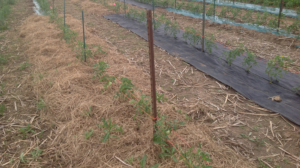
- week of 5/23: Prepared control with tractor drawn tiller and plastic mulch layer; hand-laid 4’ wide plastic mulch and landscape fabric treatments directly over live weeds; planted tomatoes in single rows, 7’ on center, 18” between plants; laid 4’ wide marsh hay mulch treatment directly over live weeds.
- 6/1: Weeded all aisles.
- 6/13: Weeded all aisles; broadcast seeded annual ryegrass (25 lb/acre) and Dutch white clover (14 lb/acre) as a living aisle; weeded all aisles a second time to work in seed.
- 6/21: Installed posts and strung first line of basket weave trellis.
- July: Mowed aisles, sprayed for disease, and trellised as needed.
- 7/26 to 9/26: Harvested tomatoes weekly.
Labor time, soil temperature, plant survivorship, and vegetable yield were recorded. An analysis of variance (ANOVA) was conducted using the R package lme4 (Bates et al 2015). Means were compared with the R package lsmeans (Lenth 2016). A confidence level of 90% was used, meaning that for each comparison that is statistically significant, we are 90% confident that the difference is due to the treatments and not to chance variation.
Results - Sorghum Sudangrass Residue for No-Till
Smothering Effect of Sorghum Sudangrass
Weed population counts taken just before rolling the sorghum sudangrass showed that weeds were well controlled. The average weed count on all farms over all treatments and reps two weeks after germination of the final treatment plots was 11.6 weeds/square foot. Just before rolling, the average weed count was 2 weeds/square foot, thus indicating that the sorghum sudangrass did act as an effective smother crop.
Unfortunately, the sorghum sudangrass also tended to smother out both the sunn hemp and the cow peas that were used in treatments 2 and 3. The average sunn hemp population count on all farms two weeks after germination was 10.3/square foot; for cow peas the number was 6.4/square foot. Just before rolling, the average sunn hemp population count on all farms was 2.6/square foot; for cow peas the number was 1.6/square foot.
Sorghum Sudangrass Biomass and Residue
A thick mulch layer is key to suppressing weeds in the cash crop production season. The goal was to produce at least 10,000 lbs. of cover crop dry matter per acre to allow for some decomposition over winter and to have an adequate mulch layer in place for the following cash crop season. Just before rolling, the average dry matter per acre across all farms and treatments was 13,165 lbs. All plots on all farms produced more than 10,000 lbs. dry matter per acre with the exception of two plots producing just 7,577 lbs. and 9,088 lbs. The high end of the range was 19,693 lbs dry matter per acre.
Sorghum Sudangrass Dry Biomass lb/acre
| 9/29/16 | 5/25/17 | |
| Blue Moon | 9,842 | 3,628 |
| Equinox | 11,565 | 4,069 |
| Crossroads | 17,470 | 3,002 |
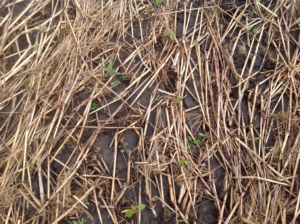
Visual inspection of the plots just before scheduled tomato planting in May 2017 showed that the remaining cover crop residue was covering only 20% to 60% of the ground leaving a high percentage of the soil exposed. Weed population counts at the same time averaged between 8 and 37 weeds per square foot, depending on the farm. Finally the cover crop biomass had dropped dramatically on all the farms. The warm February 2017 temperatures and the wet spring likely contributed to accelerated decomposition. Clearly the remaining residue would not be enough to suppress weeds during the tomato cropping season.
Based on these observations and numbers, the farmers and researchers decided to pivot the project to a comparison of supplemental mulches used with the no-till planted tomatoes.
Results - No-Till Tomato Mulches
Tomato Yield
Marketable tomatoes were harvested weekly and sorted into first and second quality fruits. Non-marketable fruits were left in the field. First quality fruits were mostly blemish free, with one small green shoulder or small healed scar allowed. Second quality fruits were small in size or had larger healed blemishes (many caused by multiple hail events). In some cases second quality fruits were beginning to show signs of disease. Non-marketable fruits were very small, diseased, or had open wounds.
First quality yield is the most important measure because those tomatoes will fetch the highest price. There was no difference in first quality yield between the no-till or the control. Nor was there a difference among the three no-till treatments. First quality yield averaged 3.58 pounds per plant. (Figure 1.)
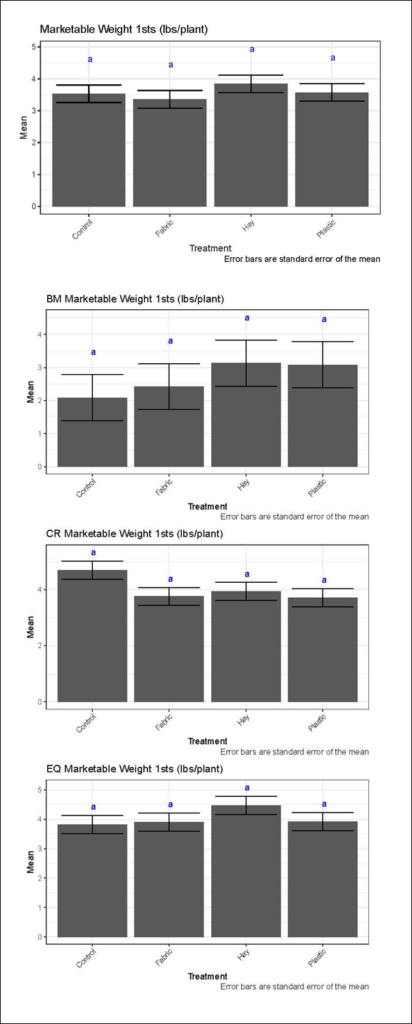
Because there were several hail events at each of the farms right after fruit set, many tomatoes were classified as seconds that would otherwise have been firsts. Thus, it is useful to also consider total yield. Total yield followed the same pattern as the first quality yield and averaged 6.31 pounds per plant. (Figure 2.)
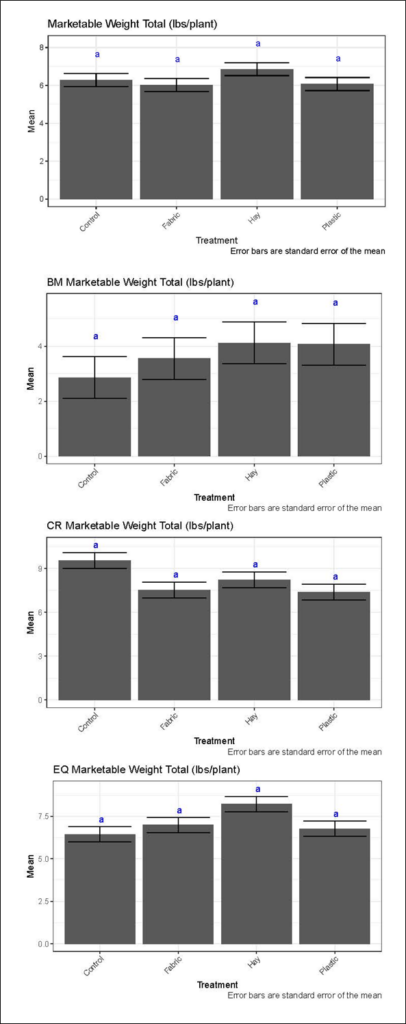
Soil Temperature
Soil temperature was recorded 6 times between June 27th and September 28th. As expected, the soil under the light colored marsh hay was lower than the plastic or landscape fabric by 3-4 degrees, which was a significant difference. (Figure 3.)
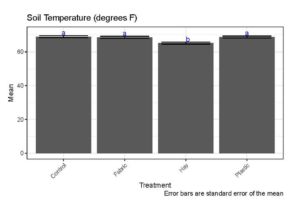
Though there was no statistical difference in the first quality yield or total yield from the marsh hay mulch, the harvest from those plots came on slower and caught up with the other treatments about six weeks into the harvest. (Figure 4.)
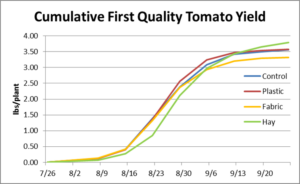
Labor
Management time for each treatment was tracked in minutes. Laying mulch, planting, weeding, trellising, and removing mulch and trellis materials were all tracked. Because harvest labor is primarily dependent on yield and is not affected by the mulch treatment, it was not tracked and is not included in the labor totals. Labor time did vary for each no-till treatment and the control, with the control requiring the least time and the no-till plastic mulch requiring the most. (Figure 5.)
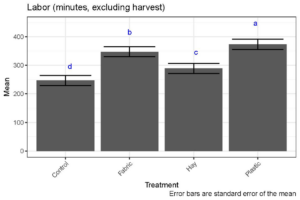
Laying plastic by hand over untilled ground meant digging a shallow trench around the stretched plastic and burying the edges with shovels. The process was not only time consuming, but also difficult. A narrow trowel was used to create a small planting hole in the plastic. That same process was used in the tilled, plastic mulch control, but was much more difficult in the untilled ground.
Removing the plastic at the end of the season did require some caution in both the treatment and the control in order to ensure that none was left buried in the soil.
Laying the landscape fabric was quick, in comparison. Sod staples pressed easily through the fabric and held securely in the firm ground. Planting into the landscape fabric was the most difficult and time consuming of any of the treatments. A sharp-edged trowel was used to cut a slit in the fabric and to create a small planting hole. Because the fabric did not puncture or tear easily, it was difficult to maneuver the plant into the untilled ground through the inflexible hole. Removing the fabric at the end of the season was more difficult than expected, as the sod staples were firmly embedded in the soil.
A narrow shovel was used to plant tomatoes into the untilled ground before the marsh hay treatment was applied. This planting process was by far the easiest because there was no mulch material in the way. At the end of the season, the drip line was easily removed and the marsh hay was left in place to decompose.
Aisles were weeded with a wheel hoe fitted with a wide stirrup blade. The durability of the landscape fabric allowed the blade to cut right up against it without causing damage, and made weeding easy. Greater caution was needed against the plastic so as not to snag and tear it. As a result, some hand-weeding was required on the plastic edges. It was also difficult to avoid snagging and moving the marsh hay with the wheel hoe, so some hand weeding was needed in that treatment as well. The planting holes in both the control and no-till plastic did allow weeds through, which required hand weeding. Planting holes in the landscape fabric did not allow weeds to grow, because the thin planting slit closed back over the soil completely. Similarly, weeds did not grow around the tomatoes in the marsh hay, because the mulch did not leave any exposed soil around the plant.
The chart below shows the degree of difficulty of each task as compared to the tractor tilled and plastic mulched control, as judged by the research crew.
| No-Till Fabric | No-Till Hay | No-Till Plastic | |
| Laying Mulch | Harder | Harder | Much Harder |
| Planting (by hand) | Much Harder | Easier | Harder |
| Weeding | Easier | Same | Same |
| Trellising | Same | Same | Same |
| Harvesting | Same | Same | Same |
| Field Clean Up | Easier | Much Easier | Same |
Weed Control
Though numerous weeds had sprouted throughout the trial area prior to laying mulch materials, only the weeds in the control were terminated (though tillage) prior to planting. In each of the no-till treatments, the mulch materials were applied directly over the living weeds. With the exception of weeds that grew in the plastic mulch planting holes, no weeds survived under any of the properly laid mulch materials. (Green plastic mulch must be stretched tight against the soil to prevent weeds.)
Material and Labor Costs
Given that there is no yield difference among the no-till treatments or the control, differences among the input and labor costs are core to this comparison. The chart below shows input and labor costs for a 100’ bed. Constant factors such as trellis materials and harvest time are not included. Though the control is clearly the most cost effective, benefits to the soil through reduced tillage and the addition of marsh hay are not quantified. These benefits could translate into decreased fertility costs or higher yields in the future.
| Control Plastic1 | No-Till Fabric2 | No-Till Marsh Hay3 | No-Till Plastic1 | |
| Mulch Materials | $4.01 | $2.77 | $25.50 | $4.01 |
| Labor Time | 248 minutes | 347 minutes | 289 minutes | 373 minutes |
| Wage | $10/hour | $10/hour | $10/hour | $10/hour |
| Labor Cost | $41.33 | $57.83 | $48.16 | $62.17 |
| Total Materials & Labor | $44.84 | $60.60 | $73.66 | $65.68 |
1Green Plastic Mulch: Nolt’s Midwest Produce Supplies, 2018 prices, 4’ by 4000’ roll is $140.50 plus $20.00 shipping from Iowa to Madison, WI. Product is not reusable and must be removed from the field.
2Black Landscape Fabric: Nolt’s Midwest Produce Supplies, 2018 prices, 4’ by 300’ roll is $56.00, 1000 6” staples are $27.50, plus $25.00 shipping from Iowa to Madison, WI. Used 24 staples per 100’ bed. Total cost spread over the expected minimum life of the product, 10 years.
3Marsh Hay Mulch: Local supplier, $4.25 per bale, 6 bales to cover 4’ by 100’. Product is not reusable and is left on the field to decompose.
Discussion
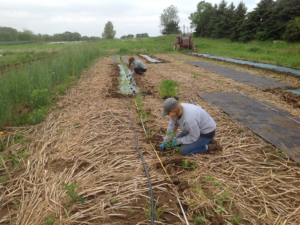
One of the most common criticisms of organic agriculture is that it relies too heavily on tillage. Tillage is known to have a negative effect on soil structure and leads to loss of organic matter and beneficial soil organisms. While organic vegetable farmers already grow cover crops, practice crop rotation, and incorporate other techniques to counteract the negative effects of tillage, the results of this trial provide additional ideas on how to include some no-till tomato practices.
Given that yield was the same across the tilled control and the no-till treatments, other cost and management considerations can come to the fore while trying to capture the benefits of no-till:
- No-Till Plastic: The relative labor cost and difficulty of laying plastic by hand, as is currently required in a no-till system, makes this the least practical option.
- No-Till Landscape Fabric: The labor cost of this treatment was higher in part because of the time consumed creating and planting into the fabric holes. This time could be reduced by laying two lengths of fabric side by side with a slight overlap, leaving a bed-length seam down the middle. Parting and planting into the seam would have been quicker and easier than the hole method we used, thus reducing the cost. In this system, the untilled ground was a benefit to laying the tarps because the staples held more firmly then they do in tilled soil. Weed control under the fabric was excellent, even though weeds were not killed before laying the material. As more farms experiment with landscape fabric for weed control, doing so in a no-till system is well worth exploring.
- No-Till Marsh Hay: Though the labor time in this system is significantly less than the other two no-till systems, the material costs are higher. That additional cost may be offset by improved soil structure and increased soil organic matter in the long-term, but it was not possible to quantify those benefits during the term of this trial. Also, though overall yield was the same in the end, the harvest in this system was delayed. This method might be valuable in conjunction with one of the other systems as a way to extend the tomato harvest season.
The spring of 2017 was wet. When it came time to plant this trial, it was difficult to find a dry spell long enough for tillage. As a result, two of the farms were tilled when soil conditions were wetter than they should have been. In the no-till plots, however, planting was unaffected by the wet conditions. In a year when planting may be delayed by wet soils, the no-till landscape fabric and no-till marsh hay systems become even more attractive as options to keep planting on schedule and avoid soil damage caused by tilling wet soils.
Recommendations for Farmers - Sorghum Sudangrass Residue for No-Till
- A disengaged rotovator can work to knock down and align sorghum sudangrass residue just prior to frost. Since the cover crop will winter-kill, the action of the disengaged rotovator is not to terminate the crop, but simply to create an aligned mulch mat that will be easy to plant into the following spring.
- Fall winds can cause the sorghum sudangrass to lodge prior to rolling, making it difficult to create an even mulch mat. Rolling prior to predicted windy conditions may be beneficial.
- Though sorghum sudangrass can produce a great deal of biomass, and is easy to align in the fall, the resulting mulch layer will not likely be enough to prevent weeds the following season. It may be suitable for no-till vegetable crop management if additional mulch is used to smother weeds.
- Be cautious of seeding cow peas or sunn hemp as leguminous companions with sorghum sudangrass. The sorghum sudangrass can smother these crops in addition to the weeds.
- Be cautious of using sunn hemp as a cover crop if you grow crops that are susceptible to Japanese beetle damage.
Recommendations for Farmers - No-Till Tomato Mulches
- Given that yield was the same between the tilled and no-till plots, it is worth experimenting with no-till organic tomatoes as a way to reduce tillage on organic farms.
- When wet soils prevent or delay tillage, the no-till landscape fabric and no-till marsh hay systems can keep tomato planting on schedule, avoid soil damage, and result in yields equal to the typical tilled and plastic mulched system. Cooperator Kristen Kordet of Blue Moon Community Farm is considering the benefits of this approach for her heavy clay soils.
- Areas where cover crops have winter-killed are great for trying out these systems. Tomatoes can be planted directly into, and mulch laid directly over, the cover crop residue with no weeding or tilling required. Weeds that sprout through the residue before tomato planting will die under the mulch materials.
- Using landscape fabric with a single row crop like tomatoes can be simplified by punch planting into cover crop residue and then laying a sheet of fabric on either side of the plants. Trellis posts can then be easily placed in the same seam, with no damage to the fabric. This method is used by farmer cooperator John Binkley at Equinox Community Farm and is faster and more protective of the mulch material than creating holes in the fabric and then planting into those, as we did in this trial.
- Tomato harvest in the no-till marsh hay system was equal to the other systems, but peaked later. It could be valuable to plant some tomatoes with marsh hay even if the bulk of the planting uses another mulch, thus extending the harvest season without using succession planting or multiple varieties. Cooperator Mike Noltnerwayss of Crossroads Community Farm is considering using marsh hay mulch alongside his usual tilled, plastic mulched system as a season extension technique.
- Though not a part of this trial, circumstances allowed the team to informally compare the taller, heavier t-posts to shorter and lighter u-posts in the tomato trellis. The u-posts were much faster and easier to install, less expensive, and just as effective for these determinate roma tomatoes.
Educational & Outreach Activities
Participation Summary:
We held a field day at Crossroads Community Farm 8/31/17. The 32 attendees toured the trial plots, received a handout with the results to date, and discussed pros and cons of organic tomato no-till.
Two bulletins and two videos with final results of the project and recommendations for organic vegetable farmers were distributed on 5/1/18 to roughly 500 farmers on 3 different distribution lists. There were over 90 views on the videos (combined) within 48 hours.
Learning Outcomes
organic tomato no-till possibilities
tomato mulches
using annual rye grass and clover in tomato aisles
Project Outcomes
Impacts
Desired Impacts
- Increased grower awareness about the benefits and challenges of reduced-tillage vegetable systems
- Increased grower knowledge about how to incorporate winter-killed cover crops into vegetable systems
- Increased grower experimentation with and adaptation of reduced tillage and alternatives to plastic mulch on their farms
Impacts to Date
Year one was devoted to reducing weeds in the trial areas and establishing the cover crop treatments in preparation for vegetable crop planting in year two. Year one results showed that while we were able to smother weeds with the sorghum sudangrass and reach our target for biomass, we also smothered the legumes in the cover crop mix and did not produce enough stable biomass to use for no-till planting in the following year.
Year two compared supplemental mulch materials in the no-till tomatoes. Results showed that yield in the no-till treatments and the tilled control were the same, though the labor committed to each system did vary. Given that there was no yield penalty, we can focus on reducing the labor commitment for no-till and making the systems more efficient and practical for farmers.
Thirty-two farmers attended the project field day on 8/31/17. Twenty-five growers submitted evaluations of the event. All but one of the respondents indicated that their knowledge about tomato techniques increased “somewhat” or “a great deal” after the event. Eighteen growers indicated that their tomato practices will change as a result of what they learned. These comments are examples of what growers said when asked “what are you planning to DO as a result of this field day?”
- “Test different no-till methods for tomatoes.”
- “I will try to use more “clean” hay around tomatoes and not just plastic.”
- “Possibly use landscape fabric with no-till cover crops, and continuing using mulch.”
- “Experiment and compare mulch methods.”
- “Experiment with ryegrass and clover.”
- “I’m going to try laying landscape fabric next year as I’ve had a hard time with removing plastic in fall.”
- It would be worthwhile to repeat the supplemental mulch part of this trial in a year when wet soils do not delay tillage. Will the yields still be the same?
- It would be helpful to know more about how to get chickling vetch to perform to its potential.
- It would be helpful to know more about appropriate seeding rates for sorghum sudangrass combined with cow peas.